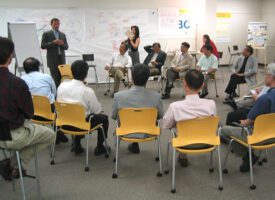A recent San Jose Mercury News article looked at innovation in Silicon Valley and what makes it tick like no other technology hotbed.
Researchers at the Massachusetts Institute of Technology (MIT) and the National Bureau of Economic Research built a map pinpointing the location of successful start-ups based on criteria such as IPO or acquisition and the factors that led to their success. It turns out that location had even more to do with it than previously thought.
Startups in Menlo Park, Mountain View, Palo Alto, and Sunnyvale (some of the cities in Silicon Valley) topped the list. Silicon Valley was ranked as the area responsible for the ideation, creation and materializing of more successful startups than anywhere else in California.
Of course, there’s a culture here in the Valley that encourages and inspires innovation. Perhaps it’s based on name-brand success stories such as Apple that have emerged, despite impossible obstacles and adversity, or company founders and serial entrepreneurs such as Max Levchin who innovate time and time again. Or it could just be the sweet taste of potential success beyond your wildest dreams. Silicon Valley is a place where rarely an idea is seldom too bold or outlandish to be given a chance.
The MIT study found that the San Francisco Bay Area has two distinct advantages:
- A higher initial quality of startups
- A broad range of elite research institutions and universities in the area, including Stanford University, UC Berkeley, UCSF and Lawrence Livermore Labs.
So if this ecosystem is solidly in place, what accelerates the innovations that lead to successful new ventures? What makes a community or area thrive when it comes to creativity and the development of unique and thoughtful products and services?

I think it’s the involvement and perseverance of extremely bright, curious, energetic and ambitious people who want to change the world in a positive way. And these creative minds want to realize their dreams in their own ventures and not have their ideas and results hidden within a large company or bureaucracy. With growing opportunities for innovators to receive serious training, education and mentoring on how to start and build companies, the risk and intimidation of starting something that matters is greatly reduced.
The trends identified in the study actually map closely to SRI’s Five Disciplines of Innovation®. We say it’s not enough just to have a bright idea—innovation comes from the creation and delivery of new customer value in the marketplace with a sustainable business model for the enterprise producing it. In short, innovating is a process, not simply an event.
In a nutshell, our approach entails:
- Identifying important customer and market needs (a big idea that has merit as confirmed through market research)
- Ensuring a unique approach (a solution that has true and clear value) to meeting those needs
- Assigning an innovation champion (a subject expert with the passion to succeed) to advocate for your cause
- Building a productive, supportive team (world class in every critical position)
- Creating organizational alignment (investors, board members, senior management, key contributors, everyone involved)
Yes, it certainly is hugely significant to be in an environment like Silicon Valley that contains world-renowned research centers and a high quality of new venture support systems, but it’s equally essential to have a proven formula for innovation to achieve ultimate success.
In case you’re interested, here are the top 10 cities for high-tech success*:
- Menlo Park
- Mountain View
- Palo Alto
- Sunnyvale
- Redwood City
- East Palo Alto
- Emeryville
- Portola Valley
- Grover Beach (San Luis Obispo)
- San Mateo
* Source: Massachusetts Institute of Technology and the National Bureau of Economic Research, Cambridge, Mass.


